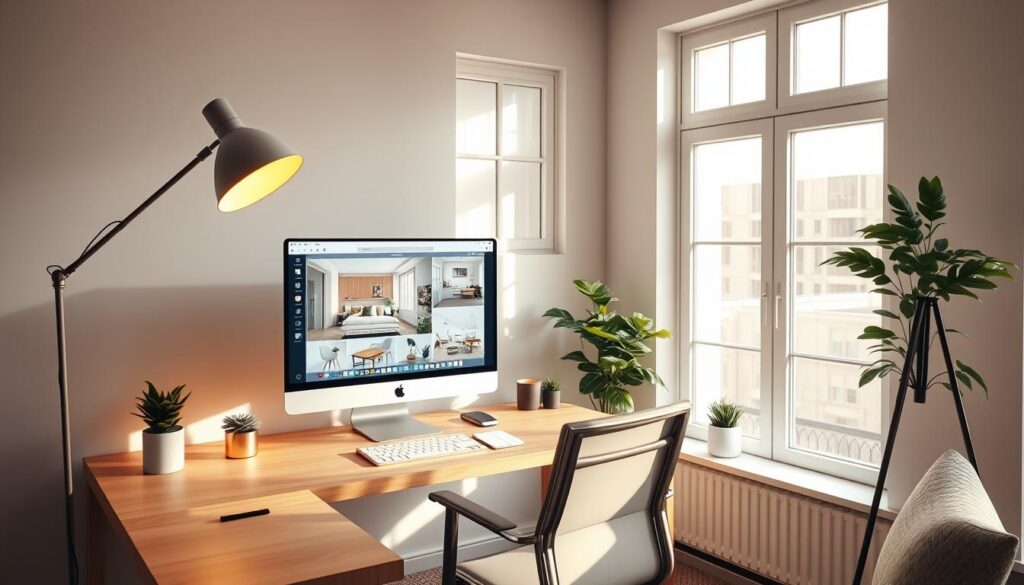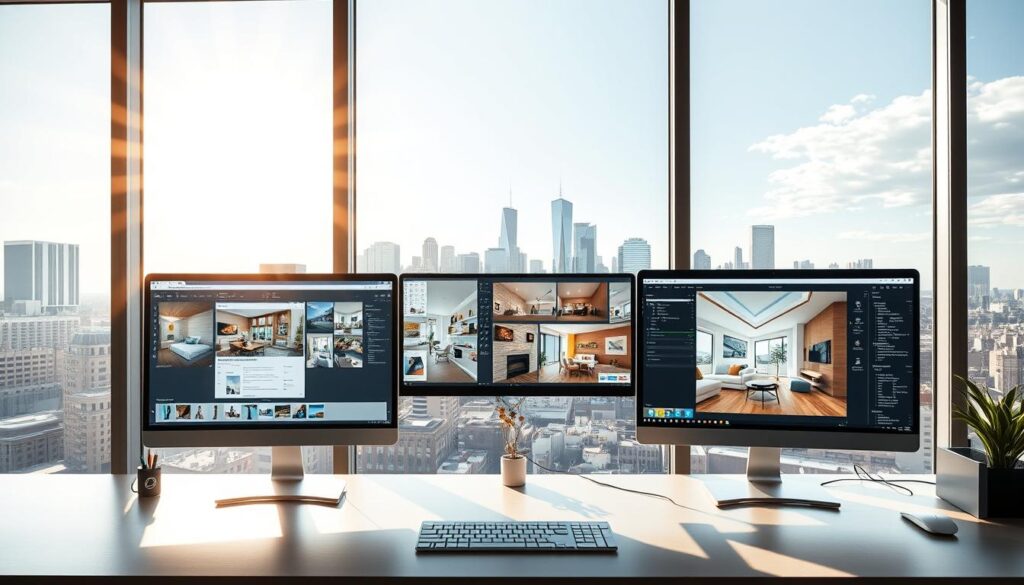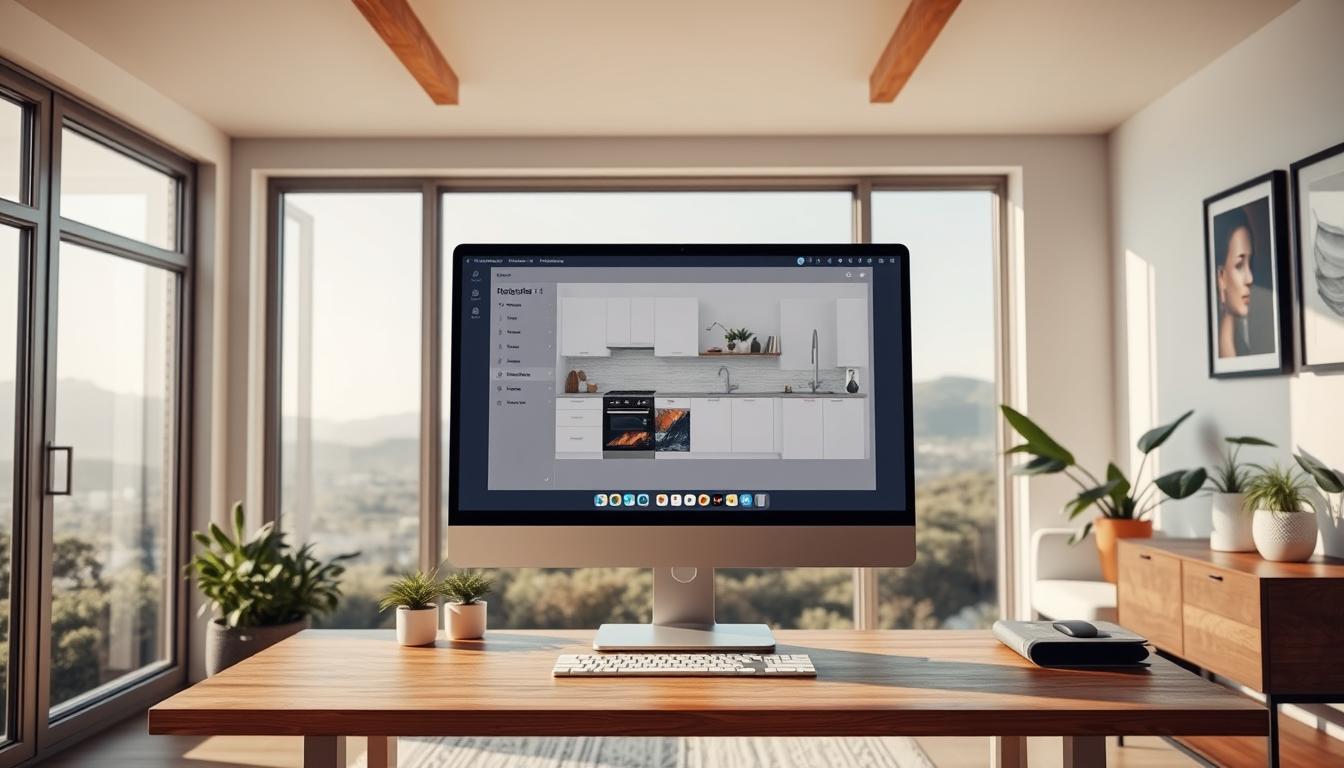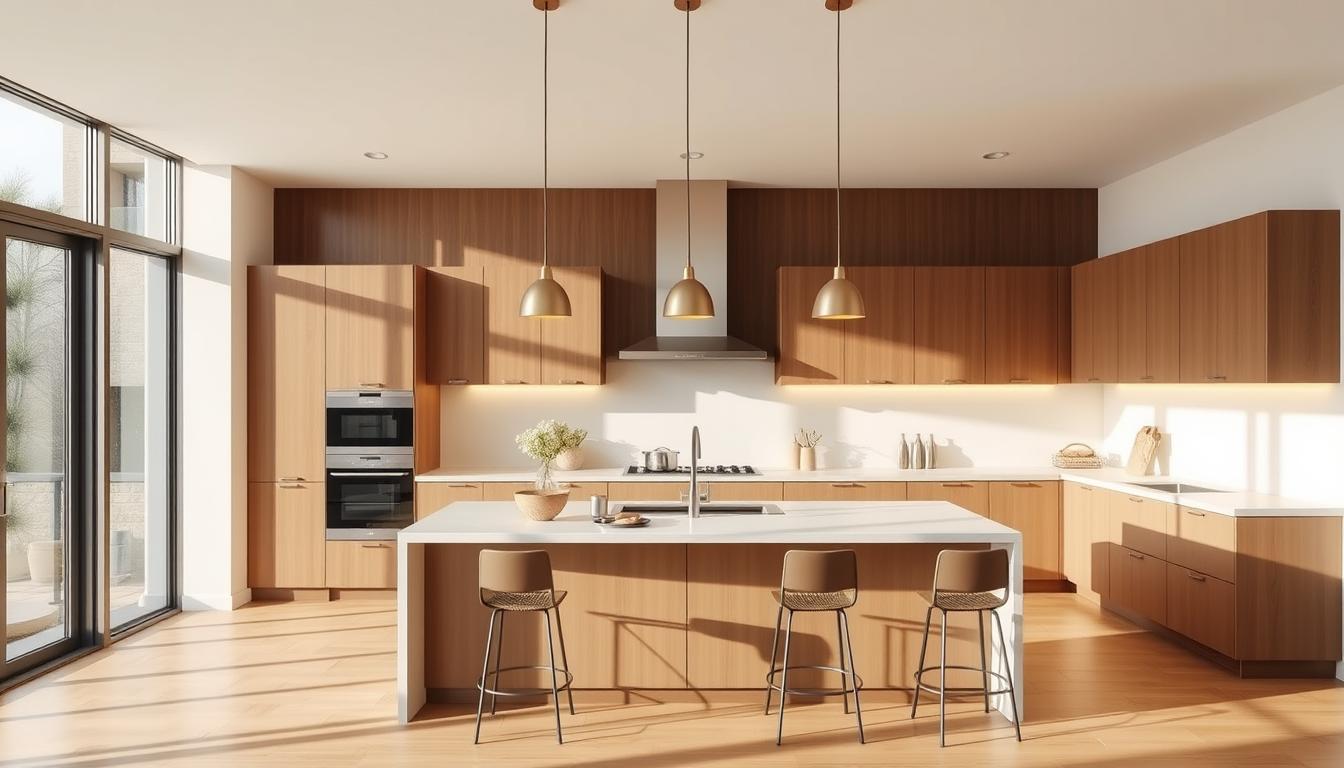Did you know a well-designed space can boost your property’s value by up to 10%? With digital tools on the rise, making over your space is easier than ever. Home interior design software is key for both homeowners and designers. It lets users plan and visualize their spaces with great detail.
We’ve picked the best interior design software out there. These tools make 2D or 3D design simple. They come with lots of features and furnishings to make your ideas real.
Key Takeaways
- Top-rated interior design software for transforming your space
- Tools that offer 2D and 3D design capabilities
- Features to simplify the design process
- A wide range of furnishings and decor options
- User-friendly interfaces for a seamless experience
Understanding Home Interior Design Software
Home interior design software is key for anyone wanting to change or decorate their home. It has changed how we design and see our living spaces.
What is Home Interior Design Software?
Home interior design software, or an interior design program, lets users create digital models of their homes. It helps them try out different layouts, decor, and design elements in a virtual space.
These programs let users see their ideas come to life. They have features like drag-and-drop and a huge library of furniture and decor. This makes it easy to turn ideas into reality.
Benefits of Using Design Software
Using home interior design software has many advantages. It saves time and money by letting users test designs virtually. This means less need for physical models or multiple changes.
- Enhanced creativity: Users can try out many styles and layouts.
- Improved accuracy: Software can measure spaces and suggest the best layouts.
- Cost-effective: It reduces the need for trial and error in real spaces.
By using an interior design program, people can get professional-looking results without needing a lot of design experience. This makes it a great tool for both homeowners and designers.
Key Features to Look for
When picking home interior design software, look for key features that boost your design experience. We want tools that meet our basic needs and offer advanced features to help us reach our design goals.
User-Friendly Interface
A user-friendly interface is key for home design software. It lets users easily navigate and focus on designing, not learning the software. MagicPlan and Chief Architect are great examples. They have easy-to-use interfaces, helping both pros and hobbyists create their designs.
Advanced Visualization Tools
Advanced visualization tools, like 3D rendering, are vital for seeing your designs come to life. These tools help you see your space in detail, making design decisions easier. For example, 3D home design software lets you see how different design elements will work together, guiding your choices.
https://www.youtube.com/watch?v=dceRdf6Bw-k
Compatibility with Devices
Being able to use your design software on different devices is important. Whether you work on a desktop, laptop, or mobile, your software should work on all. This flexibility means you can design whenever and wherever you like. For more design project resources, see our article on top home interior online stores.
| Feature | Description | Importance Level |
|---|---|---|
| User-Friendly Interface | Ease of navigation and use | High |
| Advanced Visualization Tools | 3D rendering and design visualization | High |
| Compatibility with Devices | Accessibility across different devices | Medium |
Top Home Interior Design Software Options
Choosing the right interior design software is key to transforming your space. With so many options, finding the best one can be tough.
Floorplanner is often seen as the top choice. It’s easy to use and powerful for interior design. Let’s explore some top picks, including SketchUp, Autodesk Revit, and RoomSketcher.
SketchUp
SketchUp is loved for its simple design and strong features. It has a huge library of models and extensions. It’s easy to learn and very versatile, perfect for detailed 3D models.
Autodesk Revit
Autodesk Revit is great for professionals in architecture and design. It has advanced features like Building Information Modeling (BIM). Revit’s features are worth the effort for serious designers.
RoomSketcher
RoomSketcher is popular for its easy-to-use design. It lets users make floor plans and 2D/3D designs easily. It’s perfect for both homeowners and professionals, offering many output options.
Each software has its own strengths, meeting different needs and skill levels. Whether you’re an expert or just starting, there’s a tool for you.
Software for Beginners
Starting your interior design journey means picking the right home interior design software. Beginners need a program that’s easy to use and packed with features. This way, you can turn your design dreams into reality without getting lost.
Easy-to-Use Programs
Planner 5D is a top pick for beginners. It’s an online tool that makes designing easy with its drag-and-drop feature and huge library of items. HomeByMe is also great for newbies, offering a free version for up to 5 projects.

Features Ideal for New Users
When choosing an interior design program, look for these features:
- Drag-and-Drop Interface: Makes designing simple by letting you move things around easily.
- Pre-designed Templates: Gives you a head start, saving time and boosting creativity.
- Comprehensive Object Libraries: Offers a vast selection of items to fill your designs.
- Real-time Rendering: Lets you see your design come to life as you work, helping you make better choices.
These features, along with a user-friendly interface, help beginners explore interior design. They make it easier to create beautiful spaces.
Professional-Grade Software for Experts
Professional-grade interior design software has advanced features for experienced designers. It offers precision, flexibility, and power to bring complex designs to life.
Advanced Design Capabilities
Autodesk Revit is a powerful tool for professionals. It lets them design, draft, and document precise drawings with 2D and 3D geometry. This is key for creating detailed and accurate designs.
Advanced design software also has:
- Advanced rendering capabilities to visualize designs in realistic detail
- Complex modeling tools to create intricate designs
- Integration with other software and systems for seamless workflow
Customization Options
Customization is crucial in professional-grade interior design software. Experts need to tailor designs to specific client needs. Advanced software offers this flexibility.
Users can customize everything from layout and materials to lighting and textures. This ensures the final design is both functional and aesthetically pleasing.
Some customization options include:
| Feature | Description | Benefit |
|---|---|---|
| Material Libraries | Extensive libraries of materials and textures | Allows for realistic representation of design elements |
| Lighting Controls | Advanced controls for lighting effects | Enhances the ambiance and mood of the design |
| Layout Flexibility | Ability to easily modify and adjust layouts | Streamlines the design process and improves productivity |
By using these advanced features and customization options, professionals can create stunning designs. These designs are not only visually appealing but also highly functional and tailored to clients’ needs.
Online vs. Offline Software Solutions
Home design software comes in online and offline versions. Each has its own benefits and drawbacks. It’s important to think about what you need and like when choosing.
Pros and Cons of Online Tools
Online home design software, like Planner5D, is easy to access from any device. You can work on your designs anywhere, anytime, without downloading or installing anything. Online tools often have a free version or trial, so you can try before you buy.
Key benefits of online tools include:
- Accessibility from any device with a web browser
- No need for software installation or updates
- Collaboration features for easy sharing and feedback
But, online tools need a stable internet connection. They can also be limited by your web browser’s capabilities.
Features of Offline Software
Offline home design software gives you more control over your projects. You don’t need the internet to work on your designs. These programs are often more powerful, with features not found in online versions.
Some key features of offline software include:
- Advanced design capabilities without internet limitations
- Better performance for complex projects
- No dependency on internet connectivity
Offline software installs directly on your computer. It offers a more traditional design experience.

In conclusion, choosing between online and offline home design software depends on your needs. Consider the project’s complexity, your internet, and your preferences for collaboration and accessibility.
Mobile Applications for Interior Design
Now, interior design is at your fingertips with mobile apps. These apps have changed how we design spaces, making it easier and more fun.
Advantages of Mobile Design Apps
Mobile design apps bring flexibility and convenience. You can work on designs anywhere, anytime. They have user-friendly interfaces that make designing simple for everyone.
They also let you visualize your designs in real-time. Many apps let you add designs to photos of spaces. This helps you see how your design will look.
Top Mobile Design Apps
Some top apps include MagicPlan, known for its ease and versatility. Here are a few more:
| App Name | Platform | Key Features |
|---|---|---|
| MagicPlan | Android, iOS, Web | Easy floor plan creation, real-time visualization |
| RoomSketcher | Android, iOS | User-friendly interface, detailed 2D and 3D designs |
| Planner 5D | Android, iOS, Web | Advanced 2D and 3D modeling, furniture catalog |
These apps are perfect for both pros and homeowners. They help you redesign spaces without needing to be a pro.
Budget-Friendly Design Software
Designing your dream home is now more accessible than ever, thanks to budget-friendly design software. Homeowners can create stunning interiors without spending a lot of money. There are many affordable options available.
Having the right software is key for home interior design. It helps you visualize your ideas and makes the design process smoother. Let’s look at some budget-friendly options.
Free Design Tools Available
For those on a tight budget, free design tools are a great starting point. Some popular options include:
- NCH DreamPlan: A multi-platform 3D design tool that allows you to create both indoor and outdoor projects with ease.
- RoomSketcher: A user-friendly online floor plan tool that offers a free version with substantial features.
- Sweet Home 3D: An open-source interior design software that is available for free download.
These free tools are perfect for homeowners who are just starting out or want to try different designs without spending money.
Affordable Subscriptions and Licenses
For those who need more advanced features, affordable subscriptions and licenses are available. Many software providers offer tiered pricing plans to fit different needs and budgets.
Some of the best interior design software options with affordable subscriptions include:
- Autodesk Homestyler: Offers a range of plans, including a free version and a premium subscription with additional features.
- Planner 5D: Provides a free version and several premium plans with advanced features for home interior design.
- SketchUp: Known for its user-friendly interface, SketchUp offers a free web-based version and a subscription-based model with additional features.
By choosing the right plan, homeowners can access professional-grade features without spending too much.
How to Choose the Right Software for You
Choosing the right home design software means knowing what you need and looking at what’s available. It’s important to figure out what you want to do with the software.
Assessing Your Design Needs
Think about why you need professional interior design software. Are you just updating your home, or are you a designer on big projects? What you need will help you pick the best software.
If you just want to change your furniture or pick colors, simple software might be enough. But for big projects or advanced features like 3D models, you’ll need more powerful professional interior design software.
Considering Your Budget
How much you can spend is also key. Software prices vary from free to very expensive. Decide how much you can afford and find software that fits your budget.
Some software costs a monthly fee, while others you buy once. Think about what payment method works for you. Also, remember any extra costs for updates or extra features.
By thinking about what you need and your budget, you can find the perfect home design software. It will make designing your space easier and more fun.
Tips for Effective Interior Design with Software
To get the most out of your interior design software, it’s key to know how to use it well. When using a virtual interior design tool or an interior design program, remember a few important strategies.
Planning Your Space
Effective planning is crucial. Start by measuring your space and inputting these measurements into your chosen interior design program. This will help you create a realistic design that fits your area perfectly.
Experimenting with Color and Texture
One of the benefits of using a virtual interior design tool is the ability to easily experiment with different colors and textures. Try out various combinations to see what works best for your space, and don’t be afraid to make changes until you’re satisfied with the result.
By following these tips and leveraging the capabilities of your interior design software, you can create a beautiful and functional design that enhances your living or working space.



